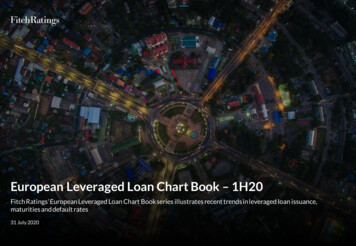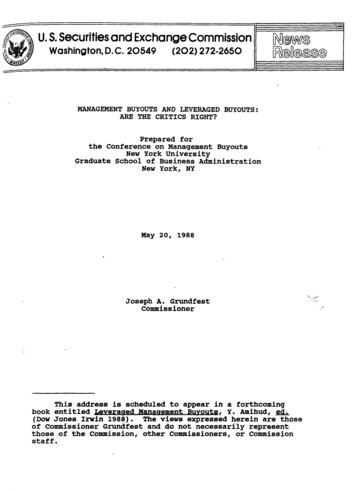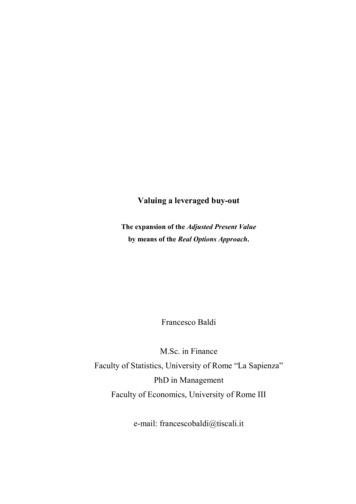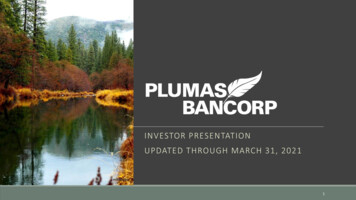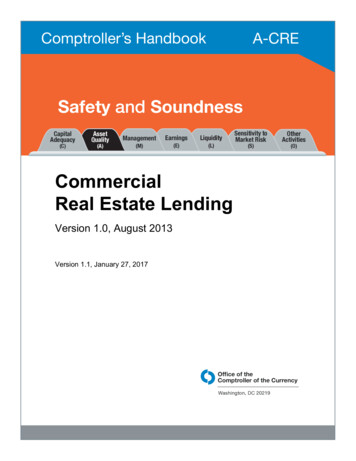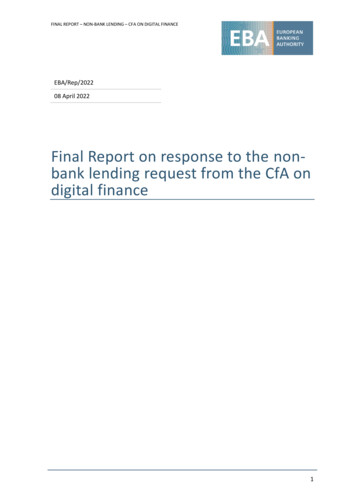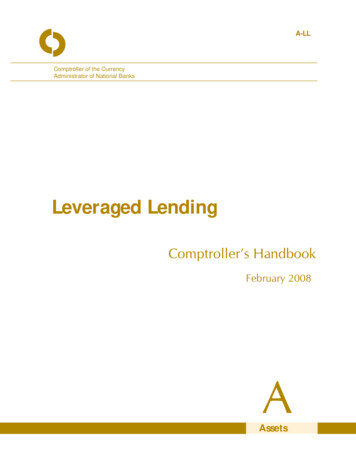
Transcription
A-LLComptroller of the CurrencyAdministrator of National BanksLeveraged LendingComptroller’s HandbookFebruary 2008AAssets
Table of ContentsLeveraged LendingIntroduction. 1Overview . 1Leveraged Lending Defined . 2Leveraged Lending and the Syndicated Loan Market . 3Distributions and Bridge Financing . 4Risks Associated with Leveraged Lending . 5Credit Risk. 5Price Risk . 8Liquidity Risk. 9Compliance Risk. 10Reputation Risk . 10Strategic Risk . 11Risk Management Guidelines and Controls. 12Loan Policy. 12Underwriting Standards . 12Policies and Procedures on Loan Acquisition and Distribution . 13Setting Concentration Limits . 14Credit Analysis . 15Risk Identification System . 15Problem Loan Management . 16Reports on Leveraged Finance Transactions . 16Internal Reviews on Leveraged Credits. 17Allowance for Loan and Lease Losses . 17Policies on Purchasing Participations in Leveraged Loans. 18Evaluating the Borrower in a Leveraged Loan Transaction . 18Understanding Enterprise Value. 20Risk-Rating Guidelines for Troubled Leveraged Loans . 22Cash Flow/Debt Service Coverage . 22Using Enterprise Value . 24The Role of Deal Sponsors. 24Conflicts Of Interest. 25Examination Procedures . 27Expanded Procedures . 27Quantity of Risk. 31Quality of Risk Management. 39Comptroller’s HandbookiLeveraged Lending
Conclusions. 46Appendix A—Adverse Risk Rating Examples . 48Appendix B—Glossary . 58Appendix C—Accounting for Leveraged Lending . 68References. 72Leveraged LendingiiComptroller’s Handbook
Leveraged LendingIntroductionThis booklet describes the fundamentals of leveraged finance. The bookletsummarizes leveraged lending risks, discusses how a bank can prudentlymanage these risks, and incorporates previous OCC guidance on the subject.One of a series of specialized lending booklets of the Comptroller’sHandbook, “Leveraged Lending” supplements the general guidance in the“Loan Portfolio Management” and “Commercial Lending” booklets.OverviewLeveraged lending is a type of corporate finance used for mergers andacquisitions, business recapitalization and refinancing, equity buyouts, andbusiness or product line build-outs and expansions. It is used to increaseshareholder returns and to monetize perceived “enterprise value” or otherintangibles. In this type of transaction, debt is commonly used as analternative to equity when financing business expansions and acquisitions. Itcan serve to support business growth and increase returns to investors byfinancing business operations that generate incremental profits against a fixedequity investment. While it is more prevalent in certain industries and withlarger companies, banks provide leveraged financing to a variety of borrowersfor a variety of reasons.Institutions participate in leveraged lending activities on a number of levels.In addition to providing senior financing, they extend or arrange credit on asubordinated basis (mezzanine financing), and can provide short-term, or“bridge,” financing to expedite the syndication process. Institutions and theiraffiliates also may take equity positions in leveraged companies with directinvestments through affiliated securities firms, small business investmentcompanies (SBICs), and venture capital companies; or they may take equityinterests through warrants and other equity “kickers” received as part of afinancing package. Institutions also may invest in leveraged loan fundsmanaged by investment banking companies or other third parties.Although leveraged financing is more prevalent in large banks, it can befound in banks of all sizes. Large banks increasingly follow an “originate-todistribute” model with respect to large loans. This model, whereby a bank orComptroller’s Handbook1Leveraged Lending
group of banks arrange, underwrite, and then market all or some portion ofthe loan facilities to third-party investors, allows the banks to earn fees whilelimiting their overall exposure to the borrower. This can be especiallyimportant in certain leveraged lending transactions, such as those financingcorporate buyouts, when the amount of the total credit facility can be quitelarge. Smaller banks participate in the leveraged loan market by eitherpurchasing participations in these large corporate loans or by making directextensions to smaller companies.Leveraged Lending DefinedNumerous definitions of leveraged lending exist throughout the financialservices industry. Depending upon the source, definitions commonly containone or more of the following conditions: Proceeds used for buyouts, acquisition, and recapitalization. Transaction results in a substantial increase in borrower’s leverage ratio.Industry benchmarks include a twofold increase in the borrower’sliabilities, resulting in a balance sheet leverage ratio (total liabilities/totalassets) higher than 50 percent, or an increase in the balance sheet leverageratio more than 75 percent. Other benchmarks include increasing theborrower’s operating leverage ratios [total debt/ EBITDA (earnings beforeinterest, taxes, depreciation, and amortization) or senior debt/EBITDA]above defined levels such as above 4.0X EBITDA or 3.0X EBITDA,respectively. Transactions designated as a highly leveraged transaction (HLT) by thesyndication agent. Borrower rated as a non-investment-grade company with a high debt tonet worth ratio. Loan pricing indicates a non-investment-grade company. This generallyconsists of some spread over LIBOR (London Interbank Offered Rate) thatfluctuates as a function of market conditions.Leveraged Lending2Comptroller’s Handbook
The OCC broadly considers a leveraged loan to be a transaction where theborrower’s post-financing leverage, when measured by debt-to-assets, debt-toequity, cash flow-to-total debt, or other such standards unique to particularindustries, significantly exceeds industry norms for leverage.Banks engaging in this type of activity should define leveraged lending withintheir lending policy. Examiners should expect the bank’s definition to clearlydescribe the purpose and financial characteristics common in thesetransactions.Leveraged Lending and the Syndicated Loan MarketThe size and complexity of characteristics inherent in many leveragedtransactions require funding through the syndicated loan market. Loansyndications offer many advantages to borrowers and lenders.Syndicated loans allow borrowers to access a larger pool of capital than anyone single lender may be prepared to make available and allow theoriginating lender the opportunity to provide greater customization than withtraditional bilateral relationship-based loans. Syndicated loans are simpler forborrowers and lenders to arrange and less costly than borrowing the sameamount from a number of lenders through traditional bilateral loanunderwritings. Moreover, there is an active secondary market, and creditratings for many leveraged loans, which permit more effective credit portfoliomanagement activities. Finally, syndicated loans provide borrowers a morecomplete array of financing and relationship-based options.Syndication of leveraged loans allows originating lenders to serve clientneeds while at the same time ensuring appropriate risk diversification in theirpermanent loan portfolios. Large bank agents and participants can alsocapitalize on a lucrative array of fee income from arranging and underwritingthe transaction as well as ancillary fee income associated with other bankingservices provided to the borrower. Corporate borrowers often require banksto participate in their credit facilities before purchasing other corporatetreasury products. Participating in a syndicate may be attractive to smallerlenders as well, since it allows them to lend to larger borrowers than theirsmaller balance sheets would allow in the case of bilateral loans. A syndicateComptroller’s Handbook3Leveraged Lending
may be valuable in workouts as it can provide for a coordinated means ofdealing with a problem borrowing situation, as opposed to an expensive andcomplex “free for all” of competing claims. However, syndicate membershipmay also contain numerous nonbank entities, including private equity groups,hedge funds, and investment conduits. These organizations may have riskappetites, investment strategies, and workout motivations that differsignificantly from bank members, complicating the workout process.Distributions and Bridge FinancingAsset sales, participations, syndication, and other means of distribution arecritical elements in the growth of leveraged financing. Distributions mostoften consist of “club” arrangements, “best effort” syndications, and“underwritten” deals.“Club” deals usually consist of smaller credits, which the arranger markets toa small group of relationship lenders. A club deal may not be governed by asingle loan agreement; however, participating lenders usually have verysimilar, if not identical, terms. “Best efforts” and “underwritten” syndicationssupport larger transaction sizes. In a best effort syndication deal, theunderwriter agrees to use all efforts to sell as much of the loan as possible.However, if the underwriter is unable to sell the entire amount of the loan,they are not responsible for funding any unsold portions. Such deals mayinclude flex language that provides for pricing changes if the credit markets orborrower’s conditions change to facilitate the arranger gaining marketacceptance for the credit. An “underwritten” deal, on the other hand, is onein which the arranger commits to the borrower the entire loan amount beforesyndication of the loan. If the arranger cannot fully syndicate the loan, it musthold the unsold portion, which exposes it to price risk.Banks can also provide temporary bridge financing during the syndicationperiod to be repaid through subsequent debt or equity offerings. Riskincreases with this activity as the source of repayment is dependent oninvestor appetite, liquidity, and market demand, which may significantlychange during this period. In addition to providing temporary financing forthe borrower’s debt, syndicating institutions may bridge the equity level ofLeveraged Lending4Comptroller’s Handbook
the transaction until the ownership group is finalized. Because national bankshave statutory restrictions against owning equity, equity bridges are typicallyprovided by the parent holding company or securities affiliate. Equity bridgescarry additional risk, including the heavy reliance on sponsors to sell equityto limited partners and other investors, potential contractual limits on salesrights, a limited secondary private equity market, and the questionable abilityto place the equity if the deal sponsor has tried and failed.Risks Associated with Leveraged LendingFor purposes of the OCC’s discussion of risk, examiners assess banking riskrelative to its impact on capital and earnings. From a supervisory perspective,risk is the potential that events, expected or unanticipated, may have anadverse impact on the bank’s capital and earnings. The OCC has defined ninecategories of risk for bank supervision purposes. These risks are credit,interest rate, liquidity, price, foreign exchange, transaction, compliance,strategic, and reputation. These categories are not mutually exclusive; anyproduct or service may expose a bank to multiple risks. For analysis anddiscussion purposes, however, the OCC identifies and assesses the risksseparately. The primary risks associated with leveraged lending are credit,price, liquidity, reputation, compliance, and strategic.Credit RiskCredit risk is the current and prospective risk to earnings or capital arisingfrom a borrower’s failure to meet the terms of any contract with a bank orotherwise to perform as agreed. Credit risk is found in all activities wheresuccess depends on counterparty, issuer, or borrower performance. It arisesany time bank funds are extended, committed, invested, or otherwiseexposed through actual or implied contractual agreements, whether reflectedon or off the balance sheet.High debt levels increase the risk of default. Leveraged borrowers’ higherdebt levels relative to their equity, income, or cash flow make it more difficultfor the borrower to withstand adverse economic conditions or business planComptroller’s Handbook5Leveraged Lending
variances, to take advantage of new business opportunities, or to makenecessary capital expenditures.The primary source of repayment in all leveraged transactions is theborrower’s ability to generate a satisfactory level of cash flows. Secondarysources of repayment include refinancing, recapitalizing, or restructuring ofdebt through the sale or disposal of the company assets or stock. When theborrower’s use of increased debt does not generate sufficient cash flows orasset values, both primary and secondary repayment sources may be quicklyand seriously impaired.Leveraged transactions, in general, are characterized by a high level of debt,increased volatility of corporate earnings and cash flow, and limited avenuesof secondary support. In addition to these more general factors, other featuresin leveraged lending activities heighten credit risk, and warrant moreintensive risk analysis, monitoring, and management. These factors include: Debt Structures and Collateral. Leveraged loans are typically structuredwith a revolving credit facility and several term loan tranches withsuccessively longer repayment terms. The revolving debt portion may besecured by a traditional borrowing base of working assets, with the termtranches collateralized by available business assets and stock. Leveragedtransactions are often characterized by a reliance on enterprise values anda financing gap between the value of the collateralized assets and theamount of the loan. As overall debt levels increase, the borrower’s needsexceed conventional collateral advance formulas. In such cases, workingcapital assets will be used to secure long-term debt, fixed asset collateralwill secure revolving facilities, and, as a result of these two events, thefinancing gap, that is, the amount of the loan not supported by collateral,may widen. These practices dilute the lender’s overall collateralprotection. In many cases, these structured transactions contain crosscollateralization and cross-default provisions, which further dilutecollateral protection for each component. Repayment Terms. Longer tenors, deferred or back-ended principalamortization, and single payment notes are increasingly common inleveraged lending structures. In many cases, the economic benefit of theLeveraged Lending6Comptroller’s Handbook
asset or transaction financed with increased leverage will not beimmediately realized by the borrower. As a result, principal repaymentrequirements are deferred or otherwise set to coincide with the realizationof expected repayment sources. This often occurs when lenders financecapital intensive or expanding businesses that must invest significantamounts of cash to fund long-term capital investments. It also occurs whenlenders finance merger and acquisition activities, and in transactionswhere asset prices and business valuations are unproven or increasingrelative to historical income and cash generation capability. Longer tenorscan be appropriate when they are coordinated with the economic use andvalue of the asset or transaction financed, as well as with the level andtiming of expected cash flows. However, they are not appropriate whenused to mask credit weaknesses related to the borrower, liberalizerepayment terms for projects that have been "over-financed," or providepermanent capital. Reliance on Refinancing or Recapitalization. Lending and equity marketscan be volatile. When markets are liquid, reflecting strong demand bybanks and institutional investors for loan assets, and attractive conditionsfor firms to issue equity, many borrowers negotiate deal structures that relyon loan refinancing or a capital issuance as the primary repayment source.Often, there is no clearly defined or realistic alternative source ofrepayment. Loan arrangements that rely on refinancing or equity issuancein the capital markets carry the added element of market risk. Marketliquidity and receptiveness can dissipate quickly for reasons beyond thecontrol of the lender or borrower and rapidly elevate risk. Reliance on “Enterprise Value” and “Airballs.” Enterprise value, which isbasically the estimated value of the borrower as a going concern, istypically used by banks to support leveraged lending arrangements whencommitted amounts exceed the borrower’s underlying tangible assetvalues. Historically, these under-collateralized positions, or “airballs,”have included accelerated or prioritized repayment, or have been held bysubordinated lenders. Enterprise values can be highly volatile as they aresubject to influences both within and beyond the control of the parties(e.g., interest rates, conditions in the industry, economy, or capitalmarkets). Valuations depend on management’s ability to achieve revenueand expense projections, and are difficult to fully support. Moreover,Comptroller’s Handbook7Leveraged Lending
enterprise value is especially susceptible to decline when most needed bythe lender, e.g., in problem situations or in an economic downturn. Interdependent Repayment Sources. Leveraged loans are oftenunderwritten with collateral liquidation, asset sales, refinancing, orrecapitalization as secondary sources of repayment. The value of suchsecondary sources is often directly linked to the strength of cash flow.Hence, their value may diminish in tandem with cash flow, thusincreasing the risk of loss in the event of default. Risk is increased evenfurther when both primary and secondary repayment sources depend onachieving performance levels (sales, income, cash flows, asset values, etc.)above those demonstrated historically. Reliance on Equity Sponsors and Agent Banks. Some banks participate inleveraged loan transactions based on the strength and reputation of equitysponsors. They believe that major equity sponsors will support theirtransactions (e.g., provide additional equity, halt dividends, furthersubordinate rights to senior lenders) in order to protect their investmentsand reputations. Lenders sometimes place too much reliance on thisinformal support. The sponsor’s primary obligation is to support itsinvestors by enhancing profits, cash flow, and, ultimately, the value of thecompany. Its ability to provide additional support is limited by the firm’slegal charter, its financial capacity, and its economic incentive to supportthe company.Price RiskPrice risk is the current and prospective risk to earnings or capital arising fromchanges in the value of traded portfolios of financial instruments. This riskarises from market making, dealing, and position-taking in interest rate,foreign exchange, and equity and commodities markets.Price risk associated with underwriting syndicated leveraged loans can behigh because changes in investor appetite can impair the originator’s ability tosell down positions as planned. Originators of leveraged loans commit creditLeveraged Lending8Comptroller’s Handbook
terms to borrowers, and then must syndicate the loans with those terms to theinvestor community.Occasionally, investor appetite for credit risk can suddenly change,sometimes sharply, and originators find that they cannot syndicate atacceptable prices the loans held in their pipeline. When this happens,originators can try to renegotiate terms with the borrower. However, exceptin unusual circumstances, borrowers or their financial sponsors have limitedincentive to make changes to credit terms that have become very favorable inlight of the changes in market conditions. Alternatively, originators can sellthe assets at a loss, hold the “stuck” loans in a held-for-sale account, orreassess their planned portfolio hold level.There are a number of unique accounting issues with respect to accountingfor syndicated loans. Refer to Appendix C, “Accounting for LeveragedLending,” for more detailed information.Liquidity RiskLiquidity risk is the current and prospective risk to earnings or capital arisingfrom a bank‘s inability to meet its obligations when they come due withoutincurring unacceptable losses. Liquidity risk includes the inability to manageunplanned decreases or changes in funding sources. Liquidity risk also arisesfrom a bank‘s failure to recognize or address changes in market conditionsthat affect the ability to liquidate assets quickly and with minimal loss invalue.Changes in investor appetite and market volatility can adversely affect theliquidity of a bank’s leveraged lending portfolio. As noted above, suchchanges can result in a bank’s need to fund (hold) a larger amount of the loanthan originally planned or distribute at a reduced price. Hold limits for allmembers in a syndicate group, regardless of role, can change from thatoriginally planned. In addition, the ability to liquidate portions of the portfolioto meet other funding requirements or take advantage of other opportunitiescan be affected significantly by the market’s demand for this asset class.Comptroller’s Handbook9Leveraged Lending
Compliance RiskCompliance risk is the current and prospective risk to earnings or capitalarising from violations of, or non-compliance with, laws, rules, regulations,prescribed practices, or ethical standards. Compliance risk also arises insituations where the laws or rules governing certain bank products oractivities of the bank’s clients may be ambiguous or untested. This riskexposes the institution to possible fines, civil money penalties, payment ofdamages, and the voiding of contracts. Compliance risk can lead to adiminished reputation, reduced franchise value, limited businessopportunities, lessened expansion potential, and lack of contractenforceability.Many larger banks originate, arrange and sell leveraged loans, in variouscapacities, through their syndication activities. Failure to meet the contractualand fiduciary responsibilities arising from these legal arrangements exposesbanks to substantial penalties and civil liability.Reputation RiskReputation risk is the current and prospective risk to earnings or capitalarising from negative public opinion. This risk affects the institution’s abilityto establish new relationships or services, or continue servicing existingrelationships. This risk can expose the institution to litigation, financial loss,or damage to its reputation. Reputation risk exposure is present throughoutthe organization and includes the responsibility to exercise an abundance ofcaution in dealing with its customers and community. This risk is present insuch activities as asset management and agency transactions.Leveraged loans are often syndicated throughout the institutional market dueto their size and risk characteristics. A bank’s failure to meet its moral, legalor fiduciary responsibilities in implementing these activities can damage itsreputation and impair its ability to compete successfully in this business line.Leveraged loans may also include the characteristics of a complex structuredfinance transaction. The activities associated with these transactions, as fullyLeveraged Lending10Comptroller’s Handbook
discussed in OCC Bulletin 2007-1, typically involve the structuring of cashflows and the allocation of risk among borrowers and investors to meet thespecific objectives of the customer in more efficient ways. They often involveprofessionals from multiple disciplines within a financial institution and maybe associated with the creation or use of one or more special purpose entitiesdesigned to address the economic, legal, tax, or accounting objectives of thecustomer. Although in the vast majority of cases, structured finance productsand the roles played by banks with respect to these products serve legitimatebusiness purposes of customers, banks may be exposed to substantialreputation and legal risks if they enter into transactions without sufficient duediligence, oversight, and internal controls.Strategic RiskStrategic risk is the current and prospective impact on earnings or capitalarising from adverse business decisions, improper implementation of adecision, or lack of responsiveness to industry changes. This risk is a functionof the compatibility of an organization’s strategic goals, the business strategiesdeveloped to achieve those goals, the resources deployed against these goals,and the quality of implementation. The resources needed to carry outbusiness strategies are both tangible and intangible. This includescommunication channels, operating systems, delivery networks, andmanagerial capacities. The organization’s internal characteristics must beevaluated against the impact of economic, technological, competitive,regulatory and environmental changes.A bank’s decision to be involved in leveraged lending requires advancedaccount and portfolio management practices. Failure of the board of directorsand bank management to provide a commensurate level of oversight andsupervision may expose the bank to significant exposure from theinterrelationship of the risk factors discussed above and from the conflicts ofinterest arising from the multiple roles in which the institution or its affiliatesmay be involved.Comptroller’s Handbook11Leveraged Lending
Risk Management Guidelines and ControlsAll banks engaging in leveraged lending activities should state in writing theirrisk objectives, underwriting standards, and controls as part of their overallcredit risk management process and policies. The lack of robust riskmanagement processes and controls in banks with significant leveragedlending activities is an unsafe and unsound banking practice. The bank’s loanpolicies should avoid compromising sound banking practices in an effort tobroaden market share or generate substantial fees.Loan PolicyA bank’s board of directors should adopt formal written policies whichspecifically address: The definition of leveraged lending and risk objectives. Loan approval requirements that require sufficient senior level oversight. Responsibilities regarding the establishment of underwriting standards,distribution practices, and credit risk management controls. Pricing policies that ensure a prudent tradeoff between risk and return. The requirement for action plans whenever cash flow, asset sale proceeds,or collateral values decline significantly from projections. Action plansshould include remedial initiatives and triggers for risk rating changes,changes to accrual status, and loss recognition.Underwriting StandardsThe following issues should be addressed either in the loan policies orspecific underwriting guidelines: Appropriate loan structures. Amortization requirements of term loans. Collateral requirements, including acceptable types of collateral, loan-tovalue limits, collateral margins, and appropriate valuation methodologies. Covenant requirements, particularly minimum interest and fixed chargecoverage and maximum leverage ratios.Leveraged Lending12Comptroller’s Handbook
How enterprise values and other intangible business values may be used,along with acceptable methodologies, and frequency and independence ofassessment reviews. Minimum documentation requirements for appraisals and valuations,including enterprise values and other intangibles. Acceptable fixed charge coverage ratios and standards for calculation. Measures of debt repayment capacity that reflect a borrower’s ability torepay debt without undue reliance on refinancing. For loans originated -for sale, the degree to which u
Handbook, “Leveraged Lending” supplements the general guidance in the “Loan Portfolio Management” and “Commercial Lending” booklets. Overview Leveraged lending is a type of corporate finance used for mergers and acquisitions, business recapitalizat
